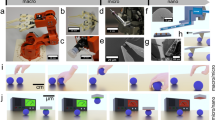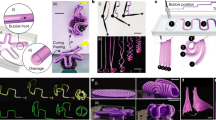Abstract
Robots have components that work together to accomplish a task. Colloids are particles, usually less than 100 µm, that are small enough that they do not settle out of solution. Colloidal robots are particles capable of functions such as sensing, computation, communication, locomotion and energy management that are all controlled by the particle itself. Their design and synthesis is an emerging area of interdisciplinary research drawing from materials science, colloid science, self-assembly, robophysics and control theory. Many colloidal robot systems approach synthetic versions of biological cells in autonomy and may find ultimate utility in bringing these specialized functions to previously inaccessible locations. This Perspective examines the emerging literature and highlights certain design principles and strategies towards the realization of colloidal robots.
This is a preview of subscription content, access via your institution
Access options
Access Nature and 54 other Nature Portfolio journals
Get Nature+, our best-value online-access subscription
$29.99 / 30 days
cancel any time
Subscribe to this journal
Receive 12 print issues and online access
$259.00 per year
only $21.58 per issue
Buy this article
- Purchase on Springer Link
- Instant access to full article PDF
Prices may be subject to local taxes which are calculated during checkout




Similar content being viewed by others
References
Jafferis, N. T. et al. Untethered flight of an insect-sized flapping-wing microscale aerial vehicle. Nature 570, 491–495 (2019).
Warneke, B. et al. Smart dust: communicating with a cubic-millimeter computer. Computer 34, 44–51 (2001).
Kalantar-Zadeh, K. et al. A human pilot trial of ingestible electronic capsules capable of sensing different gases in the gut. Nat. Electron. 1, 79–87 (2018).
Seo, D. et al. Wireless recording in the peripheral nervous system with ultrasonic neural dust. Neuron 91, 529–539 (2016).
Piech, D. K. et al. A wireless millimetre-scale implantable neural stimulator with ultrasonically powered bidirectional communication. Nat. Biomed. Eng. 4, 207–222 (2020).
Fernández-Medina, M. et al. Recent advances in nano- and micromotors. Adv. Funct. Mater. 30, 1908283 (2020).
Gómez-Martínez, R. et al. Silicon chips detect intracellular pressure changes in living cells. Nat. Nanotechnol. 8, 517–521 (2013).
Pervan, A. & Murphey, T. Bayesian particles on cyclic graphs. In IEEE/RSJ International Conference on Intelligent Robots and Systems (IEEE, 2020).
Koman, V. B. et al. Colloidal nanoelectronic state machines based on 2D materials for aerosolizable electronics. Nat. Nanotechnol. 13, 819–827 (2018).
Liu, P. et al. Autoperforation of 2D materials for generating two-terminal memristive Janus particles. Nat. Mater. 17, 1005–1012 (2018).
Thorkelsson, K., Bai, P. & Xu, T. Self-assembly and applications of anisotropic nanomaterials: a review. Nano Today 10, 48–66 (2015).
Cortese, A. J. et al. Microscopic sensors using optical wireless integrated circuits. Proc. Natl Acad. Sci. USA 117, 9173–9179 (2020).
Velegol, D. Colloidal Systems (CreateSpace, 2016).
Fan, F. & Stebe, K. J. Size-selective deposition and sorting of lyophilic colloidal particles on surfaces of patterned wettability. Langmuir 21, 1149–1152 (2005).
Wu, X. et al. A 0.04 mm3 16 nW wireless and batteryless sensor system with integrated Cortex-M0+ processor and optical communication for cellular temperature measurement. In 2018 IEEE Symposium on VLSI Circuits 191–192 (IEEE, 2018).
Funke, D. A. et al. A 200 μm by 100 μm smart dust system with an average current consumption of 1.3 nA. In 2016 IEEE International Conference on Electronics, Circuits and Systems 512–515 (IEEE, 2016).
Usami, M. An ultra-small RFID chip: µ-chip. In Proc. 2004 IEEE Asia-Pacific Conference on Advanced System Integrated Circuits 2–5 (IEEE, 2004).
Fiori, G. et al. Electronics based on two-dimensional materials. Nat. Nanotechnol. 9, 768–779 (2014).
Shulaker, M. M. et al. Three-dimensional integration of nanotechnologies for computing and data storage on a single chip. Nature 547, 74–78 (2017).
Lee, S. et al. A 250 μm × 57 μm microscale opto-electronically transduced electrodes (MOTEs) for neural recording. IEEE Trans. Biomed. Circuits Syst. 12, 1256–1266 (2018).
Miskin, M. Z. et al. Electronically integrated, mass-manufactured, microscopic robots. Nature 584, 557–561 (2020).
Hempel, M. et al. SynCells: a 60 × 60 μm2 electronic platform with remote actuation for sensing applications in constrained environments. ACS Nano 15, 8803–8812 (2021).
Weinstein, R. RFID: a technical overview and its application to the enterprise. IT Prof. 7, 27–33 (2005).
Withey, P. A. et al. Strain paint: noncontact strain measurement using single-walled carbon nanotube composite coatings. Nano Lett. 12, 3497–3500 (2012).
Park, J. et al. Trend and challenges of the diffusion-based molecular communication for nanonetworks. In 2015 International Conference on Information and Communication Technology Convergence 1362–1364 (2015).
Farra, R. et al. First-in-human testing of a wirelessly controlled drug delivery microchip. Sci. Transl. Med. 4, 122ra21 (2012).
Yang, J. F. et al. Memristor circuits for colloidal robotics: temporal access to memory, sensing, and actuation. Adv. Intell. Syst. 4, 2100205 (2022).
Ceylan, H. et al. Mobile microrobots for bioengineering applications. Lab Chip 17, 1705–1724 (2017).
Palagi, S. et al. Structured light enables biomimetic swimming and versatile locomotion of photoresponsive soft microrobots. Nat. Mater. 15, 647–653 (2016).
Miskin, M. Z. et al. Graphene-based bimorphs for micron-sized, autonomous origami machines. Proc. Natl Acad. Sci. USA 115, 466–470 (2018).
Purcell, E. M. Life at low Reynolds number. Am. J. Phys. 45, 3–11 (1977).
Blackiston, D. et al. A cellular platform for the development of synthetic living machines. Sci. Robot. 6, eabf1571 (2021).
Wan, K. Y. & Jekely, G. Origins of eukaryotic excitability. Phil. Trans. R. Soc. Lond. B 376, 20190758 (2021).
Aguilar, J. et al. A review on locomotion robophysics: the study of movement at the intersection of robotics, soft matter and dynamical systems. Rep. Prog. Phys. 79, 110001 (2016).
Aydin, Y. O. et al. in Robotic Systems and Autonomous Platforms: Advances in Materials and Manufacturing (eds Walsh, S. M. & Strano, M. S.) 109–127 (Woodhead, 2019).
Maladen, R. D. et al. Undulatory swimming in sand: subsurface locomotion of the sandfish lizard. Science 325, 314–318 (2009).
Reynolds, M. F. et al. Microscopic robots with onboard digital control. Sci. Robot. 7, eabq2296 (2022).
Moran, J. L. & Posner, J. D. Phoretic self-propulsion. Annu. Rev. Fluid Mech. 49, 511–540 (2017).
Wang, Y. et al. Bipolar electrochemical mechanism for the propulsion of catalytic nanomotors in hydrogen peroxide solutions. Langmuir 22, 10451–10456 (2006).
Wang, J. et al. A silicon nanowire as a spectrally tunable light-driven nanomotor. Adv. Mater. 29, 1701451 (2017).
Liu, A. T. et al. Autoperforation of two-dimensional materials to generate colloidal state machines capable of locomotion. Faraday Discuss. 227, 213–232 (2021).
Dou, Y. & Bishop, K. J. M. Autonomous navigation of shape-shifting microswimmers. Phys. Rev. Res. 1, 032030 (2019).
Pikul, J. H. et al. High-power lithium ion microbatteries from interdigitated three-dimensional bicontinuous nanoporous electrodes. Nat. Commun. 4, 1732 (2013).
Choi, J.-H. et al. High capacitance and energy density supercapacitor based on biomass-derived activated carbons with reduced graphene oxide binder. Carbon 132, 16–24 (2018).
González, A. et al. Review on supercapacitors: technologies and materials. Renew. Sustain. Energy Rev. 58, 1189–1206 (2016).
Liu, A. T. et al. Direct electricity generation mediated by molecular interactions with low dimensional carbon materials—a mechanistic perspective. Adv. Energy Mater. 8, 1802212 (2018).
Liu, A. T. et al. Solvent-induced electrochemistry at an electrically asymmetric carbon Janus particle. Nat. Commun. 12, 3415 (2021).
Cao, X. et al. Triboelectric nanogenerators driven self-powered electrochemical processes for energy and environmental science. Adv. Energy Mater. 6, 1600665 (2016).
Hasan, R. M. M. & Luo, X. Promising lithography techniques for next-generation logic devices. Nanomanufact. Metrol. 1, 67–81 (2018).
Gao, M., Li, L. & Song, Y. Inkjet printing wearable electronic devices. J. Mater. Chem. C 5, 2971–2993 (2017).
Visser, C. W. et al. In-air microfluidics enables rapid fabrication of emulsions, suspensions, and 3D modular (bio)materials. Sci. Adv. 4, eaao1175 (2018).
Chung, S. E. et al. Guided and fluidic self-assembly of microstructures using railed microfluidic channels. Nat. Mater. 7, 581–587 (2008).
Meitl, M. A. et al. Transfer printing by kinetic control of adhesion to an elastomeric stamp. Nat. Mater. 5, 33–38 (2005).
Kang, K. et al. Layer-by-layer assembly of two-dimensional materials into wafer-scale heterostructures. Nature 550, 229–233 (2017).
Zhang, P. et al. Fracture toughness of graphene. Nat. Commun. 5, 3782 (2014).
Rogers, J. et al. Origami MEMS and NEMS. MRS Bull. 41, 123–129 (2016).
Felton, S. et al. A method for building self-folding machines. Science 345, 644–646 (2014).
Manoharan, V. N., Elsesser, M. T. & Pine, D. J. Dense packing and symmetry in small clusters of microspheres. Science 301, 483–487 (2003).
Wang, Y. et al. Colloids with valence and specific directional bonding. Nature 491, 51–55 (2012).
Sacanna, S. et al. Lock and key colloids. Nature 464, 575–578 (2010).
Lee, H.-Y. et al. Self-assembly of nanoparticle amphiphiles with adaptive surface chemistry. ACS Nano 8, 9979–9987 (2014).
Gong, Z. et al. Patchy particles made by colloidal fusion. Nature 550, 234–238 (2017).
Grzybowski, B. A. et al. From dynamic self-assembly to networked chemical systems. Chem. Soc. Rev. 46, 5647–5678 (2017).
Xu, Z. et al. Transmembrane transport in inorganic colloidal cell-mimics. Nature 597, 220–224 (2021).
Kriegman, S. et al. A scalable pipeline for designing reconfigurable organisms. Proc. Natl Acad. Sci. USA 117, 1853–1859 (2020).
Gracias, D. H. Forming electrical networks in three dimensions by self-assembly. Science 289, 1170–1172 (2000).
Toffoli, T. & Margolus, N. Programmable matter: concepts and realization. Phys. D 47, 263–272 (1991).
Angluin, D. et al. Computation in networks of passively mobile finite-state sensors. Distrib. Comput. 18, 235–253 (2006).
Patitz, M. J. An introduction to tile-based self-assembly and a survey of recent results. Nat. Comput. 13, 195–224 (2014).
Reid, C. R. & Latty, T. Collective behaviour and swarm intelligence in slime moulds. FEMS Microbiol. Rev. 40, 798–806 (2016).
Yim, M. et al. Modular self-reconfigurable robot systems [grand challenges of robotics]. IEEE Robot. Autom. Mag. 14, 43–52 (2007).
Pervan, A. & Murphey, T. D. Low complexity control policy synthesis for embodied computation in synthetic cells. In WAFR 2018: International Workshop on the Algorithmic Foundations of Robotics (eds Morales, M. et al.) 602–618 (Springer, 2020).
Andrés Arroyo, M. et al. A stochastic approach to shortcut bridging in programmable matter. Nat. Comput. 17, 723–741 (2018).
Cannon, S. et al. A local stochastic algorithm for separation in heterogeneous self-organizing particle systems. In Proc. 2019 APPROX-RANDOM 1–22 (Schloss Dagstuhl - Leibniz-Zentrum für Informatik, 2019).
Kriegman, S. et al. Kinematic self-replication in reconfigurable organisms. Proc. Natl Acad. Sci. USA 118, e2112672118 (2021).
Savoie, W. et al. A robot made of robots: emergent transport and control of a smarticle ensemble. Sci. Robot. 4, eaax4316 (2019).
Kuang, M. et al. Inkjet printing patterned photonic crystal domes for wide viewing-angle displays by controlling the sliding three phase contact line. Adv. Opt. Mater. 2, 34–38 (2014).
Chang, J.-K. et al. Materials and processing approaches for foundry-compatible transient electronics. Proc. Natl Acad. Sci. USA 114, E5522–E5529 (2017).
Acknowledgements
The authors acknowledge financial support from the Air Force Office of Scientific Research under the MURI-FATE programmes (grant no. FA9550-15-1-0514), as well as support from ARO grant no. W911NF-19-1-0233 (award title: Formal Foundations of Algorithmic Matter and Emergent Computing) and partial support from ARO project W911NF-19-10372 (award title: Optical Communication with Synthetic Cells).
Author information
Authors and Affiliations
Corresponding authors
Ethics declarations
Competing interests
The authors declare no competing interests.
Peer review
Peer review information
Nature Materials thanks David Gracias and the other, anonymous, reviewer(s) for their contribution to the peer review of this work.
Additional information
Publisher’s note Springer Nature remains neutral with regard to jurisdictional claims in published maps and institutional affiliations.
Supplementary information
Supplementary Information
Supplementary Tables 1–4 and references.
Rights and permissions
Springer Nature or its licensor (e.g. a society or other partner) holds exclusive rights to this article under a publishing agreement with the author(s) or other rightsholder(s); author self-archiving of the accepted manuscript version of this article is solely governed by the terms of such publishing agreement and applicable law.
About this article
Cite this article
Liu, A.T., Hempel, M., Yang, J.F. et al. Colloidal robotics. Nat. Mater. 22, 1453–1462 (2023). https://doi.org/10.1038/s41563-023-01589-y
Received:
Accepted:
Published:
Issue Date:
DOI: https://doi.org/10.1038/s41563-023-01589-y



